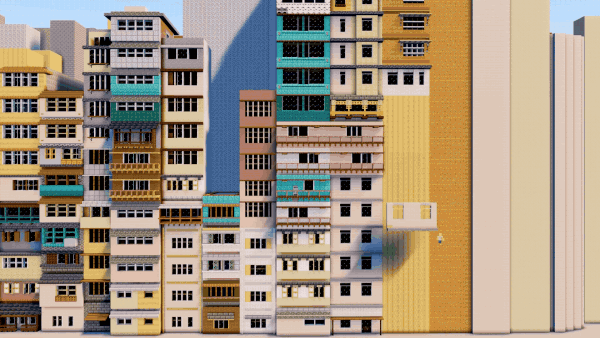

Kowloon Walled City, considered the densest settlement on the planet, was demolished in the mid-1990s. At its height in the ’80s, it was home to around 33,000 people—a government survey provided some idea of the local population—but estimates are often closer to 50,000. And that’s all within an overall footprint of 2.6 hectares, or just shy of about 6.5 acres. It’s an area smaller than five American football fields or about 2.5 New York City blocks.
A bit of an infrastructural and legal accident, Kowloon Walled City started as a Song Dynasty military outpost, then became a Qing dynasty fort in 1810. It sat within the boundaries of Kowloon City, Hong Kong, which was eventually controlled by the British after 1842’s Treaty of Nanking. But the British never really did much with the location, and for decades, only a few hundred people lived there. In 1940, only a yamen—a central government office—a school, and a single house stood in what would eventually transform into a city of monumental and overbearing proportions.
Kowloon Walled City continues to fascinate us today, as nothing on its scale had existed before and will likely never again. For an architect who goes by Sluda Builds on YouTube, the astounding, densely packed metropolis spurred an elaborate Minecraft project. From the ground up, including a surprising landscape grade that often doesn’t read clearly in photographs, he meticulously reconstructs the city’s skyscrapers, mezzanines, interior passageways, rooftops, and alleys.
Many of the Walled City’s buildings were practically conjoined, with ad hoc doorways and halls interconnected so thoroughly that, supposedly, one could travel from one side of the city to the other without ever stepping outside. And what space did exist outside was limited to narrow passages just large enough for people to get by on foot.
While today’s architects and engineers probably bristle at the myriad contemporary code violations here, the city emerged because it fell into a bit of a legal gray area due to a kind of governance limbo. Restrictions came in the form of limited space.
The British didn’t have much involvement with the walled city, and then the Nationalist Chinese Government began declaring jurisdiction in the mid-20th century. Starting in 1945, refugees of the Chinese Civil War began flooding in, with at least 2,000 settling there by 1947. By 1950, that number had grown exponentially, as a fire in 1950 destroyed the homes of more than 17,000 residents. But the metropolis kept growing from there.

Sluda’s project highlights the structural complexity of Kowloon Walled City through the bright—and very tidy—medium of Minecraft. He was drawn to the idea because not only is the settlement notorious and historically fascinating, it also possesses a strange aesthetic allure that’s difficult to pin down. He wanted to explore why it has this effect.
“These are serious high-rise buildings, some of them reaching 14 stories tall, yet constructed from the ground up in a vernacular style that’s more common in human-scale neighborhoods like the ones in Rio, for example,” Sluda says. “The sheer amount of character and personality in just one building is enough to be unique and interesting, but side-by-side visually with 50 others, all unique as well—to me, this is a major part of why this city has become so iconic.”
Check out more Minecraft projects on Sluda Builds’ YouTube channel and Instagram. You might also enjoy photographs of the city captured by Romain Jacquet-Lagrèze or Hitomi Terasawa’s now out-of-print illustrated guide, complete with elaborate cross-sections.





Do stories and artists like this matter to you? Become a Colossal Member today and support independent arts publishing for as little as $7 per month. The article Watch a Timelapse of the Notorious Kowloon Walled City Built to Scale in Minecraft appeared first on Colossal.


